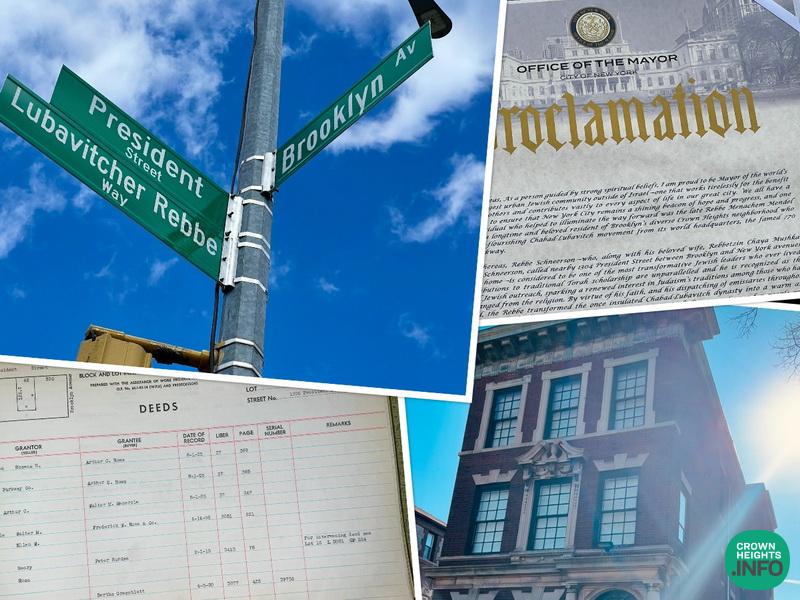
History of Crown Heights: The History of Lubavitcher Rebbe Way
by Shmully Blesofsky
President Street between Brooklyn and New York Avenues, today known as Lubavitcher Rebbe Way, is steeped in a rich history of leadership, charity, community, and Jewish pride. Before its development in the early 1900s, the land sat unused and was owned by old Brooklyn families such as the Skillmans, Delmonicas, and Schomakers.
Today, it is one of Crown Heights’ two mansion-lined blocks. It has a more open and tranquil feel than its counterpart. The stately homes are perched on a gentle rise, and the wide setbacks create a sense of quiet elegance.
Henry Roth: Visionary Builder and Community Pillar
The man who developed Lubavitcher Rebbe Way was described in newspapers as “the most distinguished Hebrew in Brooklyn.” Henry Roth was among the most respected and influential Jewish figures in early 20th-century Brooklyn. He was a man of vision, humility, and deep communal commitment. Born in Nieder, Germany, in 1860 and raised in Williamsburg, Roth was both a pioneer and a humanitarian—a worthy originator of such a distinguished block.
As president of the Henry Roth Building Company, he played a major role in developing parts of Crown Heights, Bushwick, and Williamsburg. He served as treasurer of the Welz and Zerweck Brewery Company, helping expand it into a thriving enterprise. Roth also held leadership positions in numerous civic institutions. These included the Title Guarantee and Trust Company, Sumner Savings Bank, and the Unity Club at Bedford and Dean. He was also a founder of Realty Associates.
When it came to charity work, Henry Roth’s philanthropic contributions were equally impressive. He served as treasurer of the Jewish Hospital on Classon Avenue, which became one of Brooklyn’s largest and most respected medical centers. It was especially known for providing kosher food to Jewish patients—something that was lacking in many other hospitals at the time. He also served as president of Congregation Beth Elo-kim (now home to Bnos Yakov of Pupa) and was a director of the Brooklyn Federation of Jewish Charities and the Training School for Nurses. Roth personally assisted countless poor Jewish families.
In the 1915 report of the Brooklyn Federation of Jewish Charities, Rosa Roth was esteemed as the “mother of the Women’s Auxiliary of the Jewish Hospital” and recognized as the first president of the Federation’s auxiliary board. After Henry Roth’s passing in 1918, she carried on his legacy of communal service. His death was widely mourned throughout Brooklyn as the loss of a brilliant businessman and a devoted champion of Jewish welfare.
The Brooklyn Citizen, November 22, 1908: Henry and Rosa Roth. Newspaper depicting a music ball event to raise funds for the Jewish Hospital. They were both very involved in building the Jewish hospital.
Son of Henry & Rosa Roth: Jerome Roth married to Edna Frances Seligmann
President Street’s Mansioned Blocks
The original vision for Crown Heights, as outlined in 1898 by its initial developer Frederick Rowe, was to have one house per lot. This vision was implemented on President Street between Kingston and Brooklyn Avenues, where individual lots were sold to private owners who built their own homes.
In 1908, however, those restrictions were lifted. Developer Henry Roth began purchasing lots and constructing homes on President Street between Brooklyn and New York Avenues. While he maintained the aesthetic of large stately homes, this block differed from the earlier one in that not every house was custom-built by its owner. Only select homes were individually constructed; many were built by Roth himself, often in matching architectural styles. He also introduced attached and semi-detached residences.
On the southern side of President Street, Roth preserved the natural topography, choosing not to level the land. As a result, the homes are perched on gentle rises, giving this block a distinct character and a sense of elevation and openness.
1910-11 newspaper images of President Street, showing the house built by Henry Roth, and other developers, Roth was the only one to develop the block. The house on the left is 1281 President Street, where Roth lived from 1909 to 1917. (Middle house was by Jacob Shauf 1295 President and the house on the right was Julius Strauss 1301 President Street. On uninhabited streets a few developers would sometimes build and live in some of the homes to encourage residential settlement.)
Today, though their visibility is obscured by mature trees. Of these, only 1281 President Street remains clearly visible, its stately facade unobstructed. Notably, its original front porch has since been removed.
By 1910, Henry Roth, together with two other developers, Julius Strauss and Jacob Shauf, had completed three mansions on the north side of President Street. Roth built 1281 President Street, where he lived for several years and built many of the houses on the block over the next several years.
1281 President Street circa 1940 fee
While most of the developers who arrived in Crown Heights after World War I were Russian Jews, Roth and Strauss were German Jews who belonged to the nearby Unity Club on Bedford and Dean. Based on current research, it is believed that Roth and Strauss were among the first Jews to build homes in Crown Heights during its initial development phase although they built homes as a part of their development location path as oppose to settling in tue neighborhood. The two men knew each other from the Keap Street Synagogue and were active in many charitable causes, including support for the Jewish Hospital.
Newspaper image of 1316–1318 and 1326–1328 President Street, circa 1913.
Captioned: “One of the private residences built by the Henry Roth Building Company on President Street between New York and Brooklyn Avenues.”
Circa today: The same houses at 1316–1318 and 1326–1328 President Street.
In the following years, Roth built several homes on the southern part of President Street. In 1912, he constructed 1304 President Street—a house that would later become the private residence of the Lubavitcher Rebbe. Though consistent with its architectural surroundings, the home stands out for its quiet dignity and refined elegance.
Over the decades, its residents were each leaders in their own right—deeply involved in charity, Jewish pride, and communal responsibility. The causes they supported were often too numerous to list. In hindsight, these notable individuals can be seen as a spiritual prelude, preparing the home to one day house the Rebbe and the Rebbetzin.
Deed transfers of 1304 President Street,1905-1920.
In 1913, before Jewish families had moved into the neighborhood, Peter Burden, a Scottish-born entrepreneur, and his wife, Sarah J. Burden, purchased 1304 President Street, from the developer Henry Roth, for $14,000. Peter Burden, founder of the Burden Company, a successful dry goods business with stores in Greenpoint and South Brooklyn and was also a trustee of the Greenpoint Savings Bank and an active civic leader. The Burden family lived at 1304 President Street until 1920, when they relocated to Kew Gardens. Peter Burden passed away two years later.
1913 Brooklyn Eagle: “PRESIDENT ST, S S, 355 ft e New York av, 25×125.7, H Roth & wife to P Burden, 1203 Dean st.” Recording of the sale of the house 1304 President Street”
1913 Brooklyn Eagle: “PRESIDENT ST, S S, 355 ft e New York av, Burden P & wife, to Williamsburg Savings Bank”. 1304 President Street was sold for $14,000
1922 Newspaper announcement for the death of Peter Burden.
Samuel & Bertha Greenblatt (1920–1925)
Samuel Greenblatt was articulate, confident, and deeply civic-minded, actively involved in politics, real estate, philanthropy, and Zionism. Born in Russia in 1874, he emigrated to the United States and later married Bertha Whitman in 1906 in an Orthodox ceremony. Bertha’s father, Simon Whitman, was a real estate professional and a respected leader in Jewish educational and philanthropic circles. The couple had four children.
In 1918, Greenblatt attended a pivotal meeting at the home of Louis Cohen at 1323 President Street—a gathering that led to the founding of the Brooklyn Jewish Center. That meeting may have influenced his decision to purchase 1304 President Street in 1920, where he moved with his growing family. In 1924, he hosted a reception at his home for Poland’s Chief Rabbi, Dr. Abraham Osias Thon. The following year, he sold the home and moved to Eastern Parkway. He remained an active member of the Brooklyn Jewish Center.
1323 President Street, a prominent home on Lubavitcher Rebbe Way. Known to many as the ‘Antian House’ it was built in 1915 by Louis Cohen the founder of the Brooklyn Jewish Center for $35,000. This is where the original meeting that started Brooklyn Jewish Center in 1918.
Newspaper Depicting 1323 President Street. This was the only house of President St that was also mentioned in the New York Times indicating the prominence of Louis Cohen.
Often overlooked in the story of the Brooklyn Jewish Center is the deep love for Yiddishkeit that inspired its founders. The building—now home to Oholei Torah—was established by Jews who were proud, prosperous, and deeply committed to tzedakah and Jewish continuity. Throughout his life, Greenblatt played leading roles at the Center, including efforts to raise funds for Jews stranded in Europe during the Holocaust.
Recently, Oholei Torah acquired the building at the corner of President Street and Brooklyn Avenue, adjacent to the site of that original 1918 meeting.
The new Oholei Torah building at the corner of President Street, Lubavitcher Rebbe Way, and Brooklyn Avenue.
Greenblatt also chaired major fundraising efforts for the Palestine Restoration Fund, helping to raise thousands of dollars for Jewish state-building. Later in life, he was honored by the United Jewish Appeal for his generosity and steadfast, hands-on commitment to communal causes. He served as a director of the Hebrew National School, vice president of the United Jewish Aid Societies of Brooklyn, and trustee of the Brooklyn Hebrew Orphan Asylum.
The Brooklyn Citizen, Thursday, March 27, 1924: Chief Rabbi of Poland hosted at 1304 President Street.
Brooklyn Eagle, September 13, 1925 Samuel Greenblatt selling his house and furniture. Indicated here is that it was a rushed sale, but I couldn’t find any information on why he moved.
Morris & Bertha B. Dlugash (1925–1944)
Morris Dlugash (1874–1943) was a respected real estate operator, civic leader, and philanthropist in early 20th-century Brooklyn. Born in Russia and immigrating to the United States at age 13, Dlugash became a key figure in both Jewish communal life and Brooklyn’s civic landscape. The Dlugashs lived at 1304 President Street for almost 2 decades.
Dlugash served as president and treasurer of multiple real estate corporations and held board positions at the Municipal Bank of Brooklyn. He was deeply involved in property development and financial advocacy, rising to become president of the Greater Brooklyn Property Owners Association. He worked to protect small property owners, stabilize taxes, and improve mortgage terms during difficult times.
Circa 1940: The Rebbe’s House at 1304 President Street, where the Dlugash family lived at the time.
His philanthropic work was equally distinguished. Dlugash was active at the Brooklyn Jewish Center and generously supported major Jewish causes, including Zionist fundraising and wartime relief. He played a leading role in international aid, especially for Jews suffering in Ukraine and Eastern Europe. As a member of the Brooklyn committee of the O.R.T. Reconstruction Fund, he supported vocational schools abroad and personally made the largest individual donation at a Ukraine relief event. His wife, Bertha, was also a prominent leader, active in hospital service, Hadassah, and the United Jewish Appeal. Together, they exemplified lives of generosity, civic duty, and commitment to Jewish continuity.
Samuel L. & Pauline Pomerantz (1944–1956)
Samuel L. Pomerantz (1897–1975) was an innovative and socially responsible inventor and manufacturer in the cosmetics field, best known for producing powder puffs and patented display packaging. Entrepreneurial and forward-thinking, he built a successful company that supplied department stores and retail outlets while also championing the dignity of work. He partnered with a vocational organization to employ disabled girls in his business, reflecting his strong values of inclusion, empathy, and social responsibility.
Beyond his business, Samuel and his wife Pauline were deeply involved in Jewish communal life. A 1950s Brooklyn newspaper noted: “Mr. and Mrs. Pomerantz for many years have been prominent in the activities of the Pride of Judea Children’s Home and have been closely identified with Jewish philanthropic endeavors in the borough.” The Pride of Judea was a major Jewish orphanage and child welfare agency that cared for neglected and dependent children, offering housing, education, and social support rooted in Jewish tradition.
Brooklyn Eagle, December 1939: Bar Mitzvah of Myron Pomerantz.
In 1944, Pomerantz moved from 616 Empire Boulevard to 1304 President Street with his family. He was a member of Congregation Chovevei Torah, where his son Myron celebrated his bar mitzvah. Known for his modesty and consistent support of Jewish causes, he lived with his family at 1304 President Street until 1956.
Brooklyn Eagle, December 23, 1948: Myron Pomerantz marries Dorothy Schneider.
The Rebbe’s House
The Rebbes House, 1304 President Street
The Rebbe’s House
When the Rebbe moved to America, he initially resided at 770 Eastern Parkway for a brief period. Soon after, the Rebbe and the Rebbetzin moved into an apartment on the second floor of “President Plaza” at 356 New York Avenue, on the corner of President Street.
In 1956, at the Rebbetzin’s initiative and through the efforts of the venerable and trusted chossid Reb Aaron Kazarnosky, Merkos L’Inyonei Chinuch purchased 1304 President Street. (The deed transfer was finalized two years later.) The Rebbetzin felt the house was ideal because it was modest—her father had always been opposed to luxurious homes. It should be noted that the Rebbe had no involvement in the purchase of the home.
Shortly thereafter, on Yud-Beis Tammuz, the Rebbe mentioned the subject during a farbrengen.1304 President Street, circa 1980s
Mashbak R’ Sholom Dovber Gansbourg once recalled a conversation with the Rebbetzin:
“My father told me that when a house is purchased, it should be simple and not one that ‘puts out people’s eyes.’ So when we needed to buy a house, I tried to look for a simple one, and we bought the house on President Street. However, when I sat on the porch, two bochurim walked by, and I heard one say to the other (about the house), ‘What a nice house.’ Nu, what do you say to that?”
R’ Gansbourg added:
“The Rebbetzin didn’t change anything in the structure of the house, but with her talents, she turned that simple home into a house that radiated royalty.”
(Source: Inside the Rebbe’s House – ChabadInfo.com)
After the Rebbetzin’s passing and the completion of the year of aveilus, the Rebbe moved back into 770 and instructed Reb Sholom Ber Gansbourg to sell the house. Gansbourg consulted with the Rebbe’s secretary, Rabbi Binyomin Klein, who approached Yossel Gutnick. Together they devised a plan: Yossel Gutnick would purchase the house on paper, but it would remain the Rebbe’s house in spirit and legacy.
-“It’s worth noting that years earlier, Zalman Gurarie had purchased the neighboring house to ensure the privacy of the Rebbe and Rebbetzin.
While Yossel Gutnick was eager to take on such a great zechus (merit), he insisted that there be clarity on how the arrangement would be presented to the Chassidim. When the Rebbe inquired about the sale of the house Gansbourg explained the concern. The Rebbe responded (paraphrased):
“Zol es azoy blaybn biz Moshiach kumt.”
“Let it remain this way until Moshiach comes.”
Today several times a year the Rebbes house is open to the public.
Lubavitcher Rebbe Way
In 2025, Yaacov Behrman, together with council member Crystal Hudson, led the effort to add Lubavitcher Rebbe Way as a second name to that section of President Street. Inspired by the Rebbe’s letter, which teaches that one could draw strength simply from walking past a street named after one of the Rebbeim, Behrman wanted every child to feel empowered knowing this was the Rebbe’s block.
On April 6, 2025, Yaacov Behrman organized a dignified unveiling ceremony attended by the Mayor, Attorney General, Public Advocate, borough presidents, and numerous elected officials. In recognition of the Rebbe’s enduring spiritual leadership and the sanctity his presence brought to the neighborhood, the block with a storied Jewish history was formally and appropriately designated Lubavitcher Rebbe Way.
At the historic event in honor of naming the street Lubvitcher Rebbes Way. In the background is The Rebbes House, 1304 President Street:
With the stately homes built by Henry Roth as a backdrop, and 1304 President Street at the center—a residence once home to families that exemplified Jewish leadership and kindness, such as the Greenblatts, Dlugashes, and Pomerantz -the block is now filled with families honoring its name as Lubavitcher Rebbe Way.
Proclamations of Lubavitcher Rebbe Way
Copyright (c) Shmully Blesofsky all right reserved.
Sblesof@gmail.com for permission












